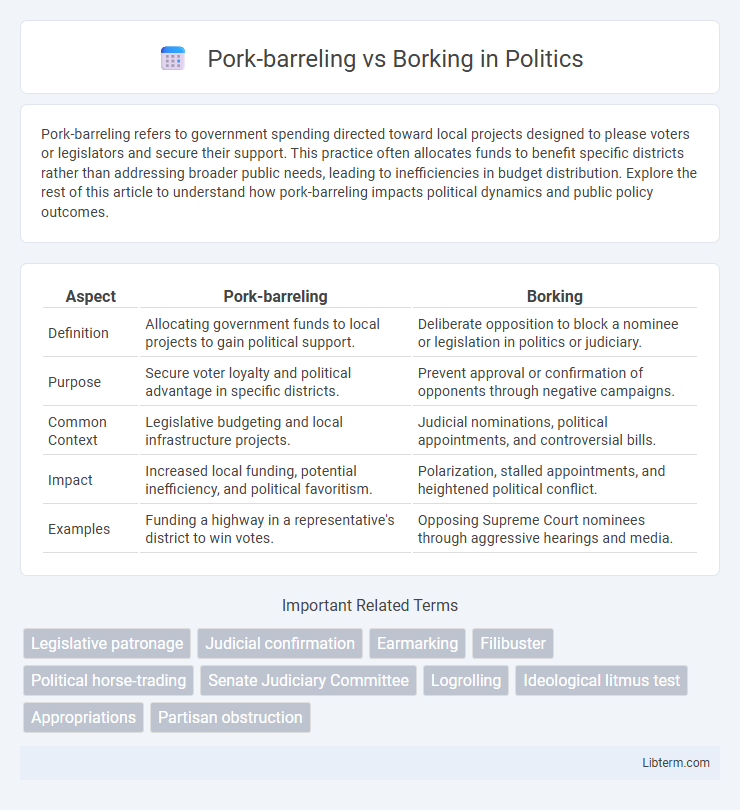Pork-barreling refers to government spending directed toward local projects designed to please voters or legislators and secure their support. This practice often allocates funds to benefit specific districts rather than addressing broader public needs, leading to inefficiencies in budget distribution. Explore the rest of this article to understand how pork-barreling impacts political dynamics and public policy outcomes.
Table of Comparison
| Aspect | Pork-barreling | Borking |
|---|---|---|
| Definition | Allocating government funds to local projects to gain political support. | Deliberate opposition to block a nominee or legislation in politics or judiciary. |
| Purpose | Secure voter loyalty and political advantage in specific districts. | Prevent approval or confirmation of opponents through negative campaigns. |
| Common Context | Legislative budgeting and local infrastructure projects. | Judicial nominations, political appointments, and controversial bills. |
| Impact | Increased local funding, potential inefficiency, and political favoritism. | Polarization, stalled appointments, and heightened political conflict. |
| Examples | Funding a highway in a representative's district to win votes. | Opposing Supreme Court nominees through aggressive hearings and media. |
Understanding Pork-Barreling: Definition and Origins
Pork-barreling refers to the allocation of government funds for localized projects secured primarily to bring money to a representative's district, often used to gain political support. Its origins trace back to early American politics, where legislators would distribute government spending to constituents, metaphorically "unlocking the pork barrel" to share resources. Understanding pork-barreling involves recognizing its role in legislative negotiation and its impact on budget allocations and political dynamics.
The Concept of Borking in Political Discourse
Borking in political discourse refers to the deliberate and systematic character assassination of a nominee or public figure to prevent their confirmation or appointment, often through aggressive media campaigns and public opposition. This tactic gained prominence during the 1987 Supreme Court nomination of Robert Bork, where intense opposition highlighted ideological conflicts and partisan strategies. Borking contrasts with pork-barreling, which involves allocating government funds to local projects to gain political favor rather than attacking an individual's reputation.
Historical Examples of Pork-Barreling
Historical examples of pork-barreling include the Tennessee Valley Authority established during the New Deal era to boost regional development and create jobs, and the Alaska Highway project funded during World War II to enhance military logistics. These initiatives directed federal funds to specific districts in exchange for political support, reflecting classic pork-barreling strategies. In contrast, borking refers to intense, often public opposition to political appointees, such as the attempt to block Robert Bork's Supreme Court nomination in 1987.
Notable Incidents of Borking in U.S. Politics
Notable incidents of borking in U.S. politics include the failed Supreme Court nomination of Robert Bork in 1987, where intense political opposition and media campaigns highlighted his judicial philosophy and led to his rejection by the Senate. Another key example is the 2018 confirmation battle over Brett Kavanaugh, marked by widespread public protests and allegations that deeply polarized the Senate and the nation. These incidents demonstrate how borking involves strategic efforts to obstruct nominees through partisan attacks and mobilized public scrutiny, contrasting with pork-barreling's focus on securing local funding through legislative means.
Key Differences Between Pork-Barreling and Borking
Pork-barreling involves directing government funds to local projects to benefit constituents and secure political support, while borking refers to the aggressive public opposition and character assassination of a nominee, especially for judicial appointments. Pork-barreling is primarily a legislative tactic aimed at resource allocation, whereas borking is a tactic used in the confirmation process to influence public opinion and derail nominations. The key difference lies in their objectives: pork-barreling seeks tangible project funding to gain votes, whereas borking targets damaging reputations to block appointments.
Impact of Pork-Barreling on Public Policy and Governance
Pork-barreling significantly impacts public policy by directing government funds to localized projects that favor specific legislators' constituencies, often leading to inefficient resource allocation and compromised policy priorities. This practice can distort governance by fostering patronage, reducing transparency, and weakening merit-based decision-making processes, ultimately undermining public trust in institutions. The concentration of benefits in certain areas may exacerbate regional inequalities and hinder comprehensive, equitable development strategies.
Effects of Borking on Judicial Nominations
Borking significantly impacts judicial nominations by intensifying partisan battles and often derailing qualified candidates through aggressive public campaigns and media scrutiny. This tactic undermines the impartial evaluation of a nominee's qualifications and jurisprudence, leading to prolonged vacancies in courts and increased polarization within the judiciary. The resulting delay in confirmations hampers the judiciary's efficiency and erodes public trust in the nomination process.
Political Strategies Involving Pork-Barreling and Borking
Pork-barreling involves directing government funds to local projects to win political support, often benefiting specific constituencies and enhancing lawmakers' reelection prospects. Borking refers to intense political opposition aimed at discrediting or blocking a nominee, especially in judicial appointments, by mobilizing negative media and public campaigns. These strategies leverage resource allocation and public perception manipulation to influence political outcomes and policymaking.
Public Perception: Pork-Barreling vs Borking
Public perception of pork-barreling centers on its role in securing local projects that benefit specific constituencies, often viewed as a necessary but sometimes wasteful aspect of political compromise. Borking, by contrast, is perceived more negatively, as a deliberate tactic to block or discredit judicial nominees through intense public campaigns, raising concerns about partisanship and undermining institutional integrity. While pork-barreling may be seen as practical and constituent-focused, Borking is widely associated with polarization and contentious political battles.
Reform and Future Trends: Addressing Political Manipulation
Reforming pork-barreling involves implementing transparency measures and stricter budget oversight to prevent local projects from being exploited for political gain. Addressing Borking requires establishing fair and objective confirmation processes that reduce partisan smear campaigns against judicial nominees. Future trends emphasize leveraging technology and bipartisan legislation to minimize political manipulation and enhance accountability in democratic institutions.
Pork-barreling Infographic

 libterm.com
libterm.com